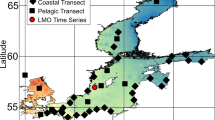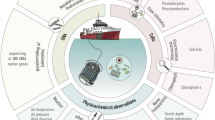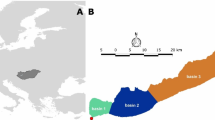Abstract
Variation in traits causes bacterial populations to respond in contrasting ways to environmental drivers. Learning about this will help us understand the ecology of individual populations in complex ecosystems. We used 454 pyrosequencing of the hypervariable region V6 of the 16S rRNA gene to study seasonal dynamics in Baltic Sea bacterioplankton communities, and link community and population changes to biological and chemical factors. Surface samples were collected from May to October 2003 and in May 2004 at the Landsort Deep in the central Baltic Sea Proper. The analysis rendered, on average, 20 200 sequence reads for each of the eight samples analyzed, providing the first detailed description of Baltic Sea bacterial communities. Community composition varied dramatically over time, supporting the idea of strong temporal shifts in bacterioplankton assemblages, and clustered according to season (including two May samples from consecutive years), suggesting repeatable seasonal succession. Overall, community change was most highly correlated with change in phosphorus concentration and temperature. Individual bacterial populations were also identified that tightly co-varied with different Cyanobacteria populations. Comparing the abundance profiles of operational taxonomic units at different phylogenetic distances revealed a weak but significant negative correlation between abundance profile similarity and genetic distance, potentially reflecting habitat filtering of evolutionarily conserved functional traits in the studied bacterioplankton.
Similar content being viewed by others
Log in or create a free account to read this content
Gain free access to this article, as well as selected content from this journal and more on nature.com
or
Accession codes
References
Acinas SG, Klepac-Ceraj V, Hunt DE, Pharino C, Ceraj I, Distel DL et al. (2004). Fine-scale phylogenetic architecture of a complex bacterial community. Nature 430: 551–554.
Allgaier M, Grossart HP . (2006). Diversity and seasonal dynamics of Actinobacteria populations in four lakes in northeastern Germany. Appl Environ Microbiol 72: 3489–3497.
Altschul SF, Madden TL, Schaffer AA, Zhang J, Zhang Z, Miller W et al. (1997). Gapped BLAST and PSI-BLAST: a new generation of protein database search programs. Nucleic Acids Res 25: 3389–3402.
Andersson AF, Lindberg M, Jakobsson H, Backhed F, Nyren P, Engstrand L . (2008). Comparative analysis of human gut microbiota by barcoded pyrosequencing. PLoS ONE 3: e2836.
Berg KA, Lyra C, Sivonen K, Paulin L, Suomalainen S, Tuomi P et al. (2009). High diversity of cultivable heterotrophic bacteria in association with cyanobacterial water blooms. ISME J 3: 314–325.
Bruno WJ, Socci ND, Halpern AL . (2000). Weighted neighbor joining: a likelihood-based approach to distance-based phylogeny reconstruction. Mol Biol Evol 17: 189–197.
Clarke KR, Ainsworth M . (1993). A method of linking multivariate community structure to environmental variables. Mar Ecol Prog Ser 92: 205–219.
Cole JR, Wang Q, Cardenas E, Fish J, Chai B, Farris RJ et al. (2009). The Ribosomal Database Project: improved alignments and new tools for rRNA analysis. Nucleic Acids Res 37 (Database issue): D141–D145.
Cotner JB, Ammerman JW, Peele ER, Bentzen E . (1997). Phosphorus-limited bacterioplankton growth in the Sargasso Sea. Aquat Microb Ecol 13: 141–149.
Crump BC, Hobbie JE . (2005). Synchrony and seasonality in bacterioplankton communities of two temperate rivers. Limnol Oceanogr 50: 1718–1729.
Crump BC, Hopkinson CS, Sogin ML, Hobbie JE . (2004). Microbial biogeography along an estuarine salinity gradient: combined influences of bacterial growth and residence time. Appl Environ Microbiol 70: 1494–1505.
Eiler A, Bertilsson S . (2004). Composition of freshwater bacterial communities associated with cyanobacterial blooms in four Swedish lakes. Environ Microbiol 6: 1228–1243.
Fandino LB, Riemann L, Steward GF, Azam F . (2005). Population dynamics of Cytophaga-Flavobacteria during marine phytoplankton blooms analyzed by real-time quantitative PCR. Aquat Microb Ecol 40: 251–257.
Fuhrman JA, Hewson I, Schwalbach MS, Steele JA, Brown MV, Naeem S . (2006). Annually reoccurring bacterial communities are predictable from ocean conditions. Proc Natl Acad Sci USA 103: 13104–13109.
Glöckner FO, Zaichikov E, Belkova N, Denissova L, Pernthaler J, Pernthaler A et al. (2000). Comparative 16S rRNA analysis of lake bacterioplankton reveals globally distributed phylogenetic clusters including an abundant group of actinobacteria. Appl Environ Microbiol 66: 5053–5065.
Hagström Å, Larsson U . (1984). Diel and seasonal variation in growth rates of pelagic bacteria. In: Hobbie JE, Williams PJL (eds). Heterotrophic Activity in the Sea. Plenum Publishing Corp: NY, USA. pp 249–262.
Haverkamp TH, Schouten D, Doeleman M, Wollenzien U, Huisman J, Stal LJ . (2009). Colorful microdiversity of Synechococcus strains (picocyanobacteria) isolated from the Baltic Sea. ISME J 3: 397–408.
Holmfeldt K, Dziallas C, Titelman J, Pohlmann K, Grossart H-P, Riemann L . (2009). Regulation of diverse and abundant freshwater Actinobacteria along environmental gradients in the brackish northern Baltic Sea. Environ Microbiol 11: 2042–2054.
Horner-Devine MC, Bohannan BJ . (2006). Phylogenetic clustering and overdispersion in bacterial communities. Ecology 87 (7 Suppl): S100–S108.
Huber JA, Mark Welch DB, Morrison HG, Huse SM, Neal PR, Butterfield DA et al. (2007). Microbial population structures in the deep marine biosphere. Science 318: 97–100.
Hunt DE, David LA, Gevers D, Preheim SP, Alm EJ, Polz MF . (2008). Resource partitioning and sympatric differentiation among closely related bacterioplankton. Science 320: 1081–1085.
Huse SM, Huber JA, Morrison HG, Sogin ML, Welch DM . (2007). Accuracy and quality of massively parallel DNA pyrosequencing. Genome Biol 8: R143.
Kan J, Crump BC, Wang K, Chen F . (2006). Bacterioplankton community in Chesapeake Bay: predictable or random assemblages. Limnol Oceanogr 51: 2157–2169.
Kent AD, Yannarell AC, Rusak JA, Triplett EW, McMahon KD . (2007). Synchrony in aquatic microbial community dynamics. ISME J 1: 38–47.
Kisand V, Andersson N, Wikner J . (2005). Bacterial freshwater species successfully immigrate to the brackish water environment in the northern Baltic. Limnol Oceanogr 50: 945–956.
Labrenz M, Jost G, Jürgens K . (2007). Distribution of abundant prokaryotic organisms in the water column of the central Baltic Sea with an oxic-anoxic interface. Aquat Microb Ecol 46: 177–190.
Ley RE, Peterson DA, Gordon JI . (2006). Ecological and evolutionary forces shaping microbial diversity in the human intestine. Cell 124: 837–848.
MacQueen JB (ed). (1967). Some methods for classification and analysis of multivariate observations. Proceedings of the 5th Berkeley Symposium on Mathematical Statistics and Probability. University of California Press, Berkeley, CA, USA.
Margulies M, Egholm M, Altman WE, Attiya S, Bader JS, Bemben LA et al. (2005). Genome sequencing in microfabricated high-density picolitre reactors. Nature 437: 376–380.
Martin AP . (2002). Phylogenetic approaches for describing and comparing the diversity of microbial communities. Appl Environ Microbiol 68: 3673–3682.
Morris RM, Vergin KL, Cho JC, Rappe MS, Carlson CA, Giovannoni SJ . (2005). Temporal and spatial response of bacterioplankton lineages to annual convective overturn at the Bermuda Atlantic Time-series Study site. Limnol Oceanogr 50: 1687–1696.
Ochman H, Lawrence JG, Groisman EA . (2000). Lateral gene transfer and the nature of bacterial innovation. Nature 405: 299–304.
Pedrós-Alio C . (2006). Marine microbial diversity: can it be determined? Trends Microbiol 14: 257–263.
Pernthaler J, Glöckner F-O, Unterholzner S, Alfreider A, Psenner R, Amann R . (1998). Seasonal community and population dynamics of pelagic bacteria and archaea in a high mountain lake. Appl Environ Microbiol 64: 4299–4306.
Philippot L, Bru D, Saby NP, Cuhel J, Arrouays D, Simek M et al. (2009). Spatial patterns of bacterial taxa in nature reflect ecological traits of deep branches of the 16S rRNA bacterial tree. Environ Microbiol (in press; advance online publication, doi:10.1111/j.1462-2920.2009.02014.x).
Pinhassi J, Hagström Å . (2000). Seasonal succession in marine bacterioplankton. Aquat Microb Ecol 21: 245–256.
Pinhassi J, Sala MM, Havskum H, Peters F, Guadayol O, Malits A et al. (2004). Changes in bacterioplankton composition under different phytoplankton regimens. Appl Environ Microbiol 70: 6753–6766.
Reynolds CS . (1984). The Ecology of Freshwater Phytoplankton. Cambridge University Press: Cambridge, UK.
Riemann L, Leitet C, Pommier T, Simu K, Holmfeldt K, Larsson U et al. (2008). The native bacterioplankton community in the central Baltic Sea is influenced by freshwater bacterial species. Appl Environ Microbiol 74: 503–515.
Riemann L, Steward GF, Azam F . (2000). Dynamics of bacterial community composition and activity during a mesocosm diatom bloom. Appl Environ Microbiol 66: 578–587.
Riemann L, Winding A . (2001). Community dynamics of free-living and particle-associated bacterial assemblages during a freshwater phytoplankton bloom. Microb Ecol 42: 274–285.
Rönnberg C, Bonsdorff E . (2004). Baltic Sea eutrophication: area-specific ecological consequences. Hydrobiologia 514: 227–241.
Schauer M, Balagué V, Pedrós-Alió C, Massana R . (2003). Seasonal changes in the taxonomic composition of bacterioplankton in a coastal oligotrophic system. Aquat Microb Ecol 31: 163–174.
Selje N, Simon M . (2003). Composition and dynamics of particle-associated and free-living bacterial communities in the Weser estuary, Germany. Aquat Microb Ecol 30: 221–237.
Shade A, Kent AD, Jones SE, Newton RJ, Triplett EW, McMahon KD . (2007). Interannual dynamics and phenology of bacterial communities in a eutrophic lake. Limnol Oceanogr 52: 487–494.
Shiah F-K, Ducklow W . (1994). Temperature regulation of heterotrophic bacterioplankton abundance, production, and specific growth rate in Chesapeake Bay. Limnol Oceanogr 39: 1243–1258.
Slingsby JA, Verboom GA . (2006). Phylogenetic relatedness limits co-occurrence at fine spatial scales: evidence from the schoenoid sedges (Cyperaceae: Schoeneae) of the Cape Floristic Region, South Africa. Am Nat 168: 14–27.
Snel B, Bork P, Huynen MA . (1999). Genome phylogeny based on gene content. Nat Genet 21: 108–110.
Sogin ML, Morrison HG, Huber JA, Mark Welch D, Huse SM, Neal PR et al. (2006). Microbial diversity in the deep sea and the underexplored ‘rare biosphere’. Proc Natl Acad Sci USA 103: 12115–12120.
Stal LJ, Albertano P, Bergman B, Bröckel K, Gallon JR, Hayes PK et al. (2003). BASIC: Baltic Sea cyanobacteria. An investigation of the structure and dynamics of water blooms of cyanobacteria in the Baltic Sea—responses to a changing environment. Cont Shelf Res 23: 1695–1714.
Stigebrandt A . (2001). Physical oceanography of the Baltic Sea. In: Wulff F, Rahm L, Larsson P (eds). A Systems Analysis of the Baltic Sea. Springer Verlag: Heidelberg, Germany, pp 19–74.
Stoeck T, Epstein S . (2009). Crystal ball—2009: protists and the rare biosphere. Environ Microbiol Rep 1: 20–22.
Troussellier M, Schäfer H, Batailler N, Bernard L, Courties C, Lebaron P et al. (2002). Bacterial activity and genetic richness along an estuarine gradient (Rhone River plume, France). Aquat Microb Ecol 28: 13–24.
Warnecke F, Amann R, Pernthaler J . (2004). Actinobacterial 16S rRNA genes from freshwater habitats cluster in four distinct lineages. Environ Microbiol 6: 242–253.
Webb CO . (2000). Exploring the phylogenetic structure of ecological communities: an example for rain forest trees. Am Nat 156: 145–155.
Wulff F, Stigebrandt A . (1989). A time-dependent budget model for nutrients in the Baltic Sea. Glob Biogeochem Cycles 3: 63–78.
Zwart G, van Hannen EJ, Kamst-van Agterveld MP, Van der Gucht K, Lindstrom ES, Van Wichelen J et al. (2003). Rapid screening for freshwater bacterial groups by using reverse line blot hybridization. Appl Environ Microbiol 69: 5875–5883.
Zweifel UL, Norrman B, Hagström Å . (1993). Consumption of dissolved organic matter by marine bacteria and demand for inorganic nutrients. Mar Ecol Prog Ser 101: 23–32.
Acknowledgements
This study was supported by the Swedish Research Council (grants to SB and LR) and the Carl Trygger Foundation (grant to AFA). We thank Ulf Larsson, Leif Lundgren and Berndt Abrahamsson, Department of Systems Ecology, Stockholm University, for help with environmental data and sampling. Pyrosequencing was provided by the International Census of Marine Microbes (ICoMM) with financial support from a WM Keck foundation award to the Marine Biological Laboratory at Woods Hole. We thank the entire ICoMM team for their support during the completion of the study.
Author information
Authors and Affiliations
Corresponding authors
Additional information
Supplementary Information accompanies the paper on The ISME Journal website (http://www.nature.com/ismej)
Supplementary information
Rights and permissions
About this article
Cite this article
Andersson, A., Riemann, L. & Bertilsson, S. Pyrosequencing reveals contrasting seasonal dynamics of taxa within Baltic Sea bacterioplankton communities. ISME J 4, 171–181 (2010). https://doi.org/10.1038/ismej.2009.108
Received:
Revised:
Accepted:
Published:
Issue date:
DOI: https://doi.org/10.1038/ismej.2009.108
Keywords
This article is cited by
-
A comprehensive dataset on spatiotemporal variation of microbial plankton communities in the Baltic Sea
Scientific Data (2024)
-
Multiyear analysis uncovers coordinated seasonality in stocks and composition of the planktonic food web in the Baltic Sea proper
Scientific Reports (2023)
-
Geographic Scale Influences the Interactivities Between Determinism and Stochasticity in the Assembly of Sedimentary Microbial Communities on the South China Sea Shelf
Microbial Ecology (2023)
-
Seasonal Succession and Coherence Among Bacteria and Microeukaryotes in Lake Baikal
Microbial Ecology (2022)
-
Ecologically coherent population structure of uncultivated bacterioplankton
The ISME Journal (2021)



